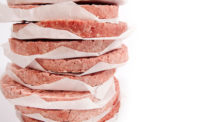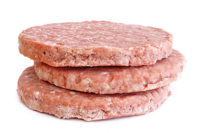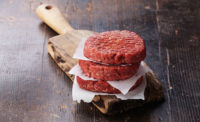Tech | Processing
Automating Interleaving
Automating Interleaving

sampsyseeds/E+ / via Getty Images
Employment at U.S. meat, beef and poultry processing plants currently stands around 500,000 and is expected to grow 0.4 percent by the end of 2021, according to Meat, Beef and Poultry Processing Industry in the U.S.,” a September 2020 market research report from IBISWorld.
Recruiting and retaining workers was a pre-pandemic challenge and continues to be a concern as plants strive to keep workers safe.
With recruitment and retention an ongoing need, interest in automation appears to be growing. Automating manual operations allows personnel to be shifted to more value-added tasks, can eliminate repetitive motion and associated injuries and enhance product consistency, quality and portion control. Reducing worker contact with the products, especially ready-to-eat items such as lunch meat, also exerts a positive impact on food safety.
Functions well-suited to automating include interleaving and stacking. Shifting from a manual to a machine-based operation boosts production. Even the most basic machines can triple the output of a human operator. The highest speed machines run more than 10 times faster.
The latest interleaving and stacking equipment, including starwheel, Ferris wheel, platform and patty stackers, is designed for enhanced food safety with hygienic design, quick disassembly and cleaning and washdown-compatible components.
Interleaving — positioned under, between or around a meat, poultry or seafood product — improves package presentation and enhances separation, freeze release, shelf life and convenience for the user. Convenience remains at the top of consumer wish lists. This trend has only strengthened as more meals are being cooked from home because a significant percentage of the population is working from home with kids who are attending school virtually and indoor restaurant dining is discouraged by health experts and largely unavailable in some places. As a result, foods that need minimal preparation time such as portion-packed lunch meat for sandwiches or frozen hamburger patties are found on many family shopping lists. Interleaving separates portions and also can prevent multi-serving frozen products from fusing into blocks.
Interleaving options include standard and custom waxed and coated papers, parchment paper and plastic film in rollstock or sheet form. Different grades, colors and sizes are available. Materials also may be printed. Packaging protects the interleaving material from contamination before use. Optimizing the interleaving substrate can help maximize output and minimize downtime. Important characteristics for machinability include consistent size, thickness, stiffness, tear strength and tensile value. Other important considerations include determining the best coefficient of friction for the product as well as the proper balance between wet strength and freeze release. It also should be noted that coatings such as wax can build up on equipment and add downtime for cleaning. In some cases, it may be possible to integrate additives into the substrate itself and eliminate the need for coatings that can accumulate on the equipment as the material moves through.
But the biggest innovation in interleaving is the development of substrates that perform a function beyond product separation. Potential value-added functions include product flavoring, traceability, microbial control and pathogen detection. Such functionality offers the opportunity to increase shelf life, enhance food safety before and after the package is opened, track products through the supply chain and cut costs. NP
Looking for a reprint of this article?
From high-res PDFs to custom plaques, order your copy today!






